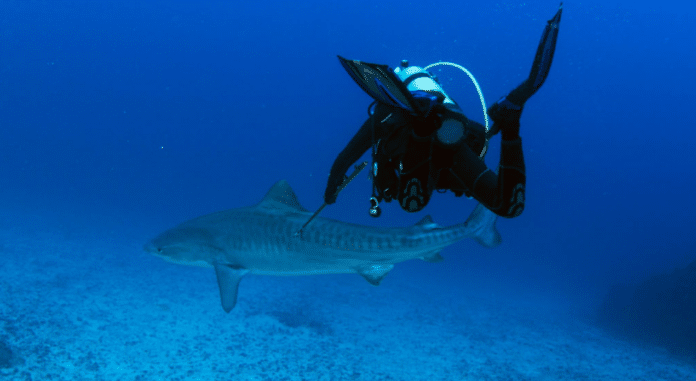A scientist based out of California has successfully tagged a shark that is believed to have killed an American scuba diver and seriously injure another in November 2017.
Todd Steiner, founder and executive director of the Turtle Island Restoration Network (TIRN), tagged the 14-foot/4-meter female tiger shark during one of the organization’s yearly research expeditions to Cocos Island National Park 350 miles off the Costa Rican coast.
Using scuba and a six-foot pole spear, Steiner was able to place an acoustic transmitter below its dorsal fin in order to monitor its habitat use at Cocos Island National Park for the next two or more years.
According to Steiner:
“I love Cocos Island, and dive fees revenue from recreational divers is critically important to sustain the conservation activities at this National Park. We need to better understand this shark’s habitat use in order to keep divers and wildlife safe, and acoustic telemetry is one of the best and most reliable tools we can use.”
The tiger shark, nicknamed Lagertha after the women warrior in the History Channel’s “Vikings” TV show, and also nicknamed by others as Victoria, is believed to be the same shark that attacked two divers in November 2017, leaving one dead and one seriously injured. It was the first shark attack at Cocos Island and only the fourth recorded in Costa Rican history. While no images were taken in the wake of the initial attack, this particular shark is easily recognized by unique scars and spots on its dorsal fin and has shown aggressive behavior to divers, causing dives to be aborted for safety reasons.
Based on his personal experience on more than 600 dives at Cocos Island, Steiner said:
“Sometimes a tiger shark will appear curious and will make one close swim-by before continuing on their way. The 2017 attack is the only confirmed attack despite more than 20,000 recreational divers and hundreds of thousands of dives at Cocos since 1993.”
Steiner, along with a crew of volunteer divers, set off on a research expedition in early December aboard Undersea Hunter’s MV Argo, a 130-foot/40-meter liveaboard dive vessel. Alfredo Barroso, an Emmy Award-winning underwater cameraman who was filming the research expedition for an upcoming documentary, said they were in about 60 feet/18 meters of water when the shark showed up.
Barroso, who has logged more than 6,000 dives around the world, said:
“It was showing no fear of the divers and was slowly and continuously circling us, closing its eyes, which is often a sign of a possible imminent attack. Todd charged the animal and tagged it from about a foot away, causing the shark to swim off and giving us time to get safely back on our skiff.”
Steiner has been studying sea turtles and sharks at Cocos Island since 2007 in partnership with the Costa Rican-based Rescue Center for Endangered Marine Species (CREMA) and its founder Randall Arauz, setting up acoustic listening devices at all major dive sites in the Park.
Following the 2017 attack only a few days after it occurred, TIRN’s team was the first to dive the site of the attack at the request of the Costa Rica National Park Service, as well as during the time when the site was closed by the Costa Rican government to recreational divers.
With the help of scientific partners from around the region, TIRN’s studies at Cocos Island have uncovered an underwater migratory wildlife superhighway for at least three species of sharks and two species of sea turtle. This superhighway connects Costa Rica’s Cocos Island with Ecuador’s Galapagos. The collaboration of scientists working in the region is called “MigraMar,” where Steiner is a founding board member and currently serves as secretary.
Steiner said:
“Our data has provided the impetus for the creation of a 240,000 square mile marine protected area, known as the Cocos-Galapagos Swimway. We are actively working with the governments of Costa Rica and Ecuador, along with several additional partners, to create the first bilateral agreement that will allow endangered species to migrate safely outside the small marine protected areas that surround these two reserves and connect two sovereign nation’s marine National Parks.”
TIRN has organized more than 25 expeditions to Cocos Island, utilizing a crew of volunteer citizen-scientist divers, and set off on the most recent research 10-day expedition in early December. In addition to a new understanding of sea turtle and shark migrations throughout the region, the research has provided the basis for better protections for endangered marine wildlife impacted by industrial fishing operations.
For more info about the Turtle Island Restoration Network including how to participate in an upcoming research expedition, go to www.seaturtles.org.
Also, check out this DeeperBlue.com story about the role of shark diving in conservation.

